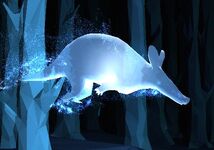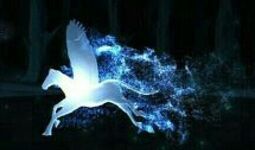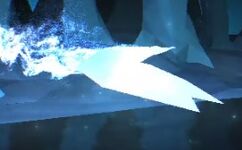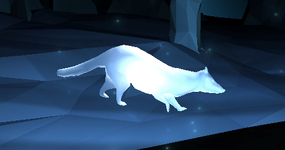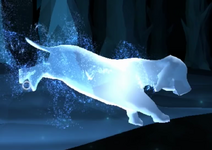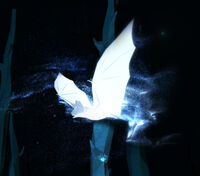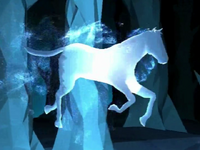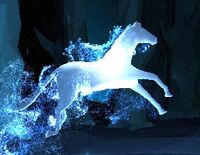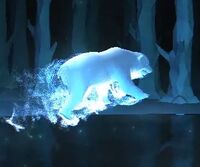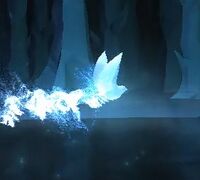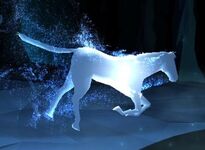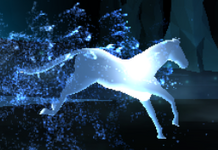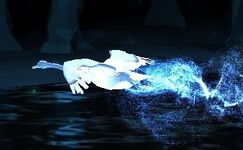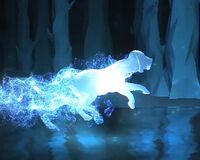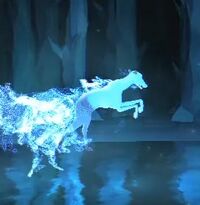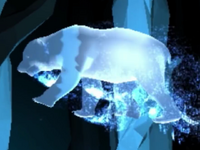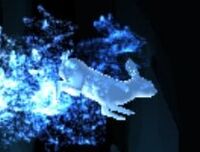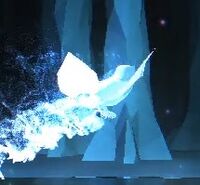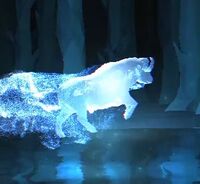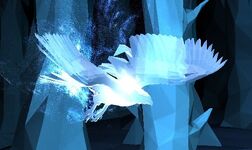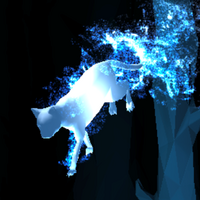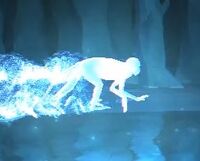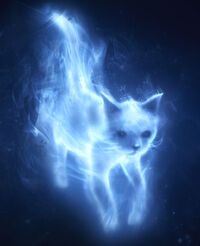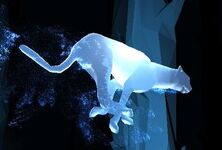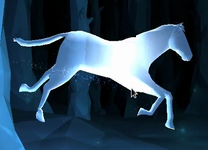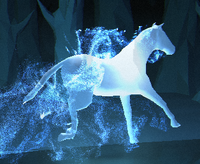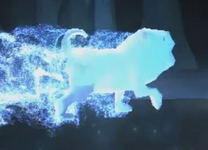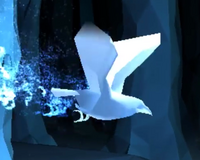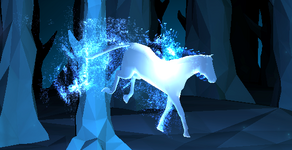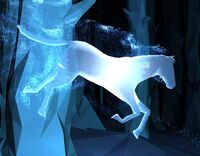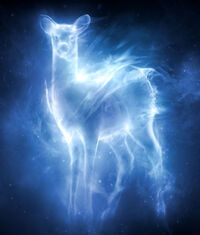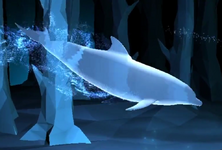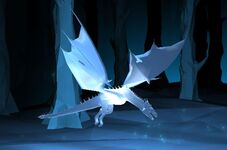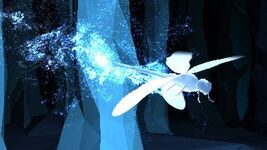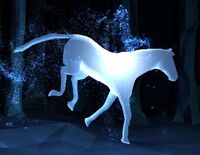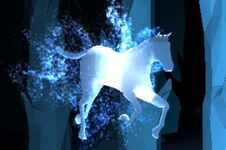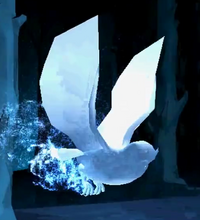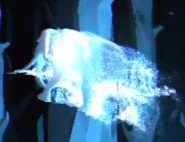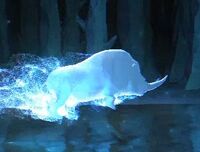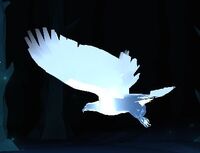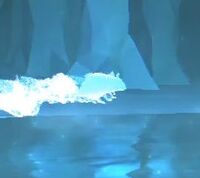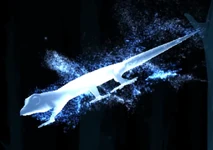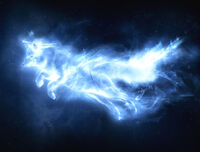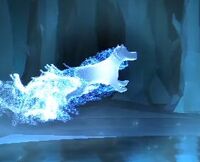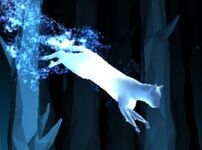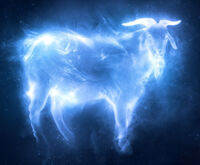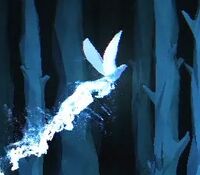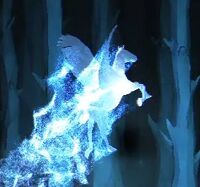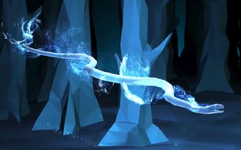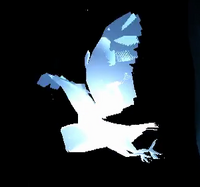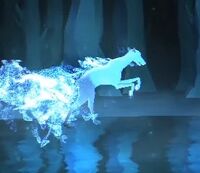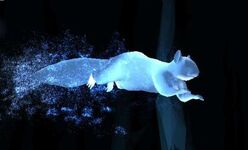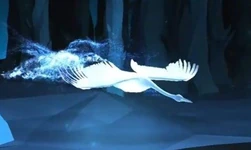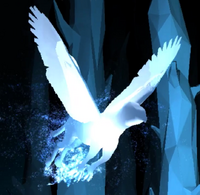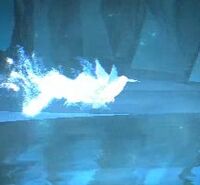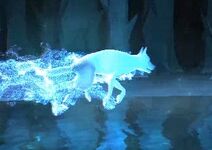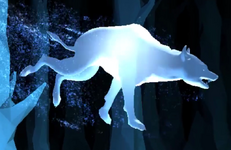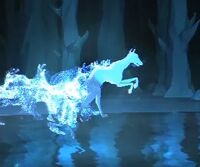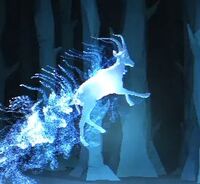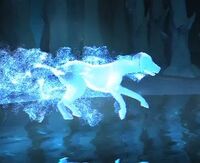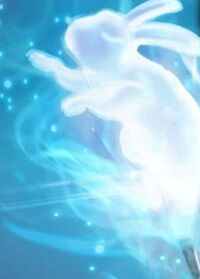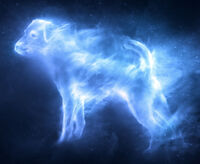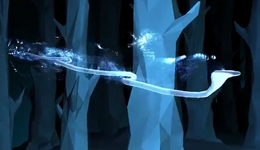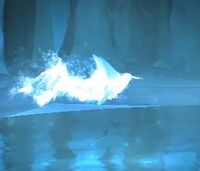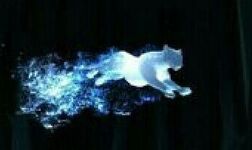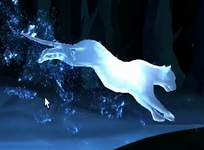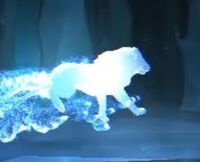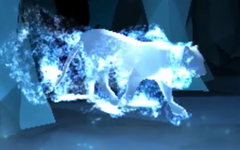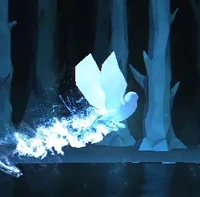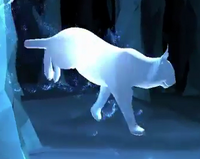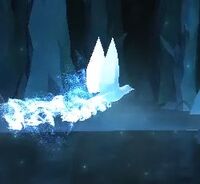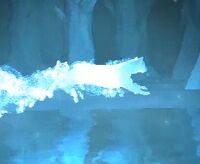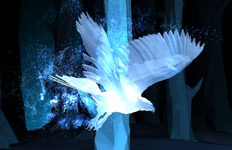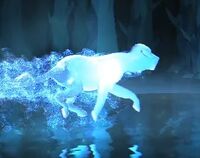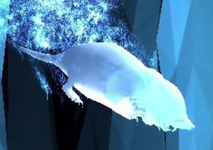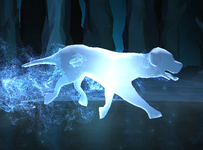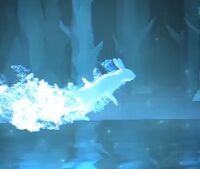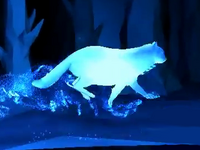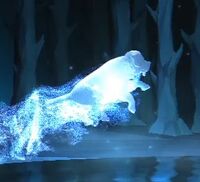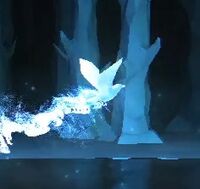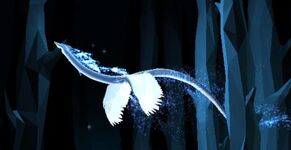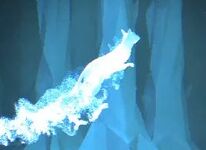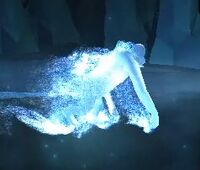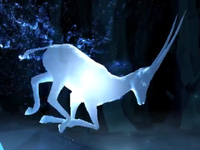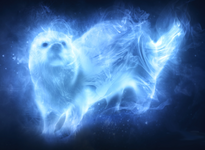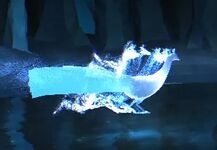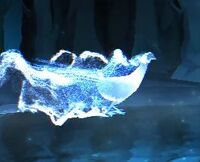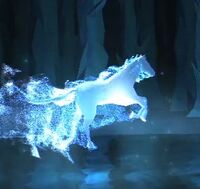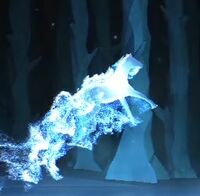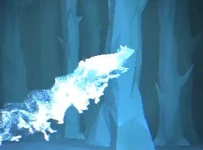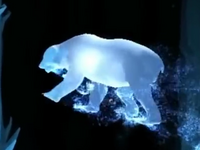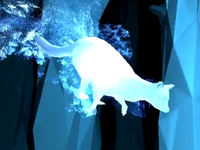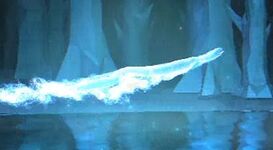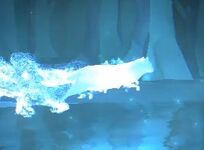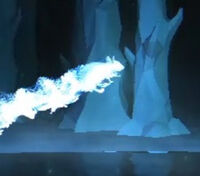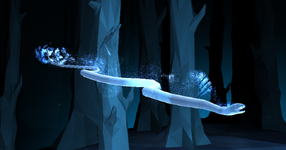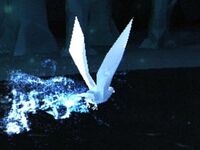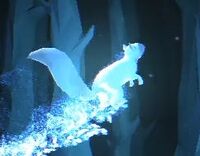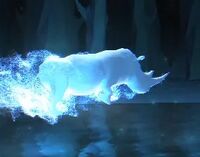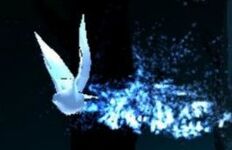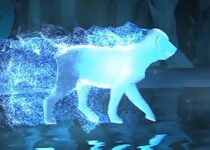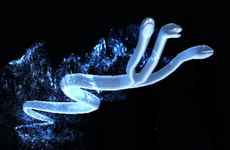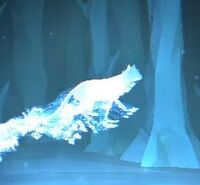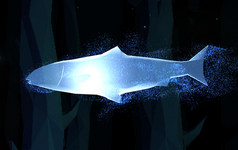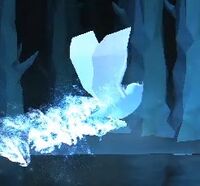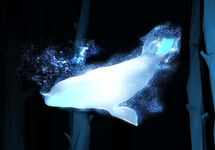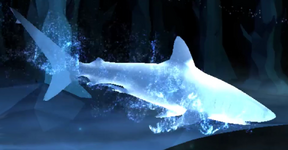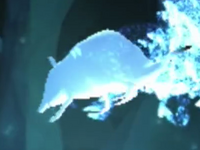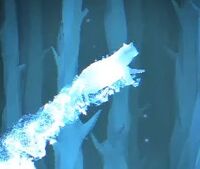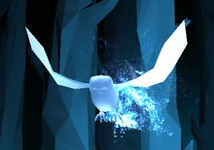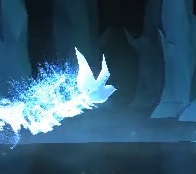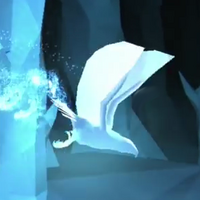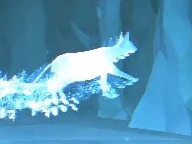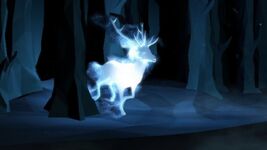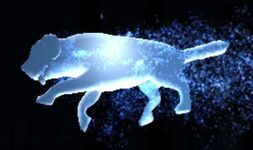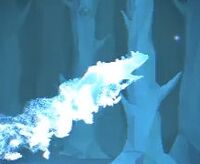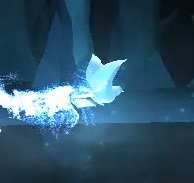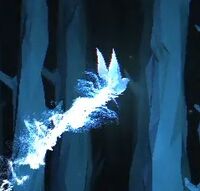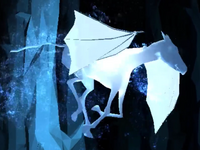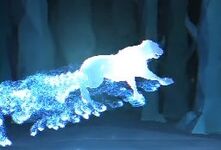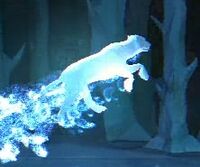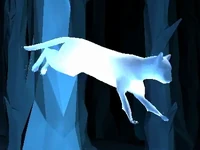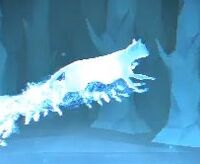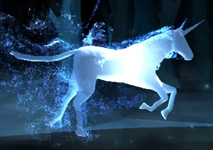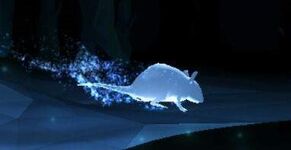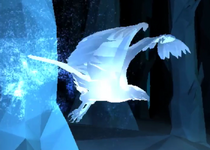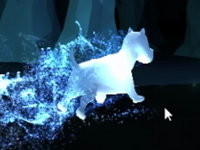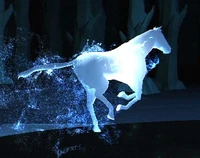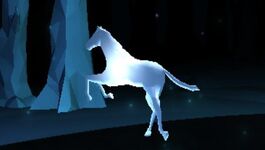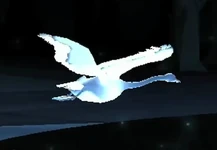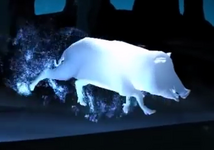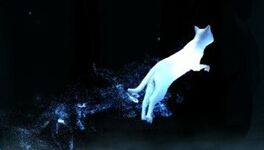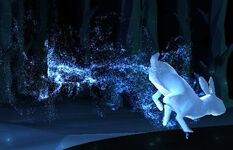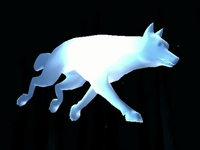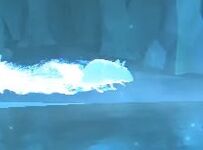RedWizard98 (talk | contribs) No edit summary |
No edit summary |
||
| Line 1: | Line 1: | ||
{{Spoiler|WU|HM}} |
{{Spoiler|WU|HM}} |
||
{{FA}} |
{{FA}} |
||
| + | {{F.A. Nomination}} |
||
{{Spell infobox |
{{Spell infobox |
||
|name = Patronus Charm |
|name = Patronus Charm |
||
Revision as of 00:31, 28 September 2020

|
Warning!
At least some content in this article is derived from information featured in: Harry Potter: Wizards Unite & Harry Potter: Hogwarts Mystery. |
- "This ancient and mysterious charm conjures a magical guardian, a projection of all your most positive feelings. The Patronus Charm is difficult, and many witches and wizards are unable to produce a full, corporeal Patronus, a guardian which generally takes the shape of the animal with whom they share the deepest affinity. You may suspect, but you will never truly know what form your Patronus will take until you succeed in conjuring it."
- — Miranda Goshawk's overview of the Patronus Charm[src]
The Patronus Charm (Expecto Patronum) was the most famous and one of the most powerful defensive charms known to wizardkind.[4] It was an immensely complicated and an extremely difficult spell, that evoked a partially-tangible positive energy force known as a Patronus (pl. Patronuses)[5] or spirit guardian.[3] It was the primary protection against Dementors and Lethifolds, against which there were no other defence.
There are two types of Patronuses: corporeal which means a Patronus with a particular shape and form and incorporeal Patronus. Incorporeal Patronuses have no particular shape and do not protect against dementors the way corporeal Patronuses do. However, some wizards like Remus Lupin choose to cast incorporeal Patronuses to hide their identity.[1]
History
- "And out of the end of his wand burst, not a shapeless cloud of mist, but a blinding, dazzling, silver animal. He screwed up his eyes, trying to see what it was. It looked like a horse. It was galloping silently away from him, across the black surface of the lake. He saw it lower its head and charge at the swarming dementors... "
- — Harry Potter's stag Patronus fending off hundreds of Dementors[src]
It is evident from old woodcuts and scrolls that the Patronus Charm has been used since ancient times. Therefore, it is unknown who created it, or when it was first invented.[6] The charm also has a long association with those fighting for lofty or noble causes (those able to produce corporeal Patronuses were often elected to high office within the Wizengamot and Ministry of Magic).[4]
According to legend, one of the most famous Patronuses of all time was a lowly mouse, which belonged to a young wizard called Illyius. Illyius cast the Patronus Charm when his village was being attacked by the Dark wizard Raczidian and his army of Dementors. Despite the mouse's diminutive size, it shone with a brilliant light, bringing the Dementors to a halt as it nimbly moved through the ranks of fleeing villagers.[6] Enraged, Raczidian decided to enter the fray himself, and tried to summon a Patronus to ward off Illyius's mouse. However, he failed to remember that only the pure of heart can produce a Patronus and thus, for the first time in history, it was revealed what happens when a competent, but unworthy wizard or witch attempts the spell; maggots shot out of Raczidian's wand and quickly devoured him as they engulfed his entire body. The villagers then hailed Illyius as a hero.[6]
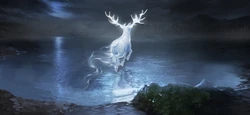
Harry Potter's stag Patronus fending off hundreds of Dementors
Harry Potter took Anti-Dementor lessons with Remus Lupin in order to learn the advanced charm and so was one of the youngest to attempt this charm with actual results.[1] During a Quidditch match against Ravenclaw in 1994, he cast his very first corporeal Patronus, when several Slytherin students were impersonating Dementors.[7] He performed the charm again in June when he, along with Hermione Granger and Sirius Black, were being attacked by over a hundred Dementors, so he cast a corporeal Patronus powerful enough to drive them all away.[8][9]
In 1995, Harry cast the charm against a Boggart that he thought was a Dementor during the third task of the Triwizard Tournament.[10] The following summer, he came under attack by two Dementors and managed to drive them away with the charm, leading to him being put on trial for underage magic in an attempt to discredit him.[11]
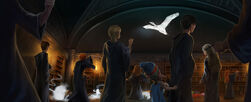
Harry Potter teaching the members of the D.A. the charm
Harry also taught the members of Dumbledore's Army the charm and some were even successful in casting it.[11]
The charm was used frequently to ward off Dementors such as when The Trio escaped from the Ministry of Magic after obtaining the Horcrux locket and during the Battle of Hogwarts. Severus Snape also conjured his Doe Patronus to guide Harry to the hiding place of the Sword of Gryffindor.[12]
The Order of the Phoenix would send out messages with their Patronuses such as Kingsley Shacklebolt and Arthur Weasley who in 1997 delivered warnings.[12]
Nature
The Patronus represents that which is hidden, unknown but necessary within the personality. When a human is confronted with inhuman evil, such as the Dementor, they must draw upon resources he or she may never have needed, and the Patronus is the awakened secret self that lies dormant until needed, but which must now be brought to light. Patronuses take forms that their casters might not expect, for which they have never felt a particular affinity, or (in rare cases) even recognise. Every Patronus is as unique as its creator and even identical twins have been known to produce very different Patronuses.[4]
The unusual witches and wizards who produce a Patronus that takes the form of their favourite animal is an indicator of obsession or eccentricity. Here is a wizard who may not be able to hide their essential self in common life, who may, indeed, parade tendencies that others might prefer to conceal. Whatever the form of their Patronus, you would be well-advised to show respect, and occasionally caution, towards a witch or wizard who produces the Patronus of their choice.[4]
Remus Lupin owned a spellbook which detailed the casting of the Patronus Charm.[13]
Casting
- Harry Potter: "And how do you conjure it?"
- Remus Lupin: "With an incantation, which will work only if you are concentrating, with all your might, on a single, very happy memory."
- — Discussion on how to conjure a Patronus[src]
The vast majority of witches and wizards are unable to produce any form of Patronus, and to create even an intangible one is generally considered a mark of superior magical ability.[4] Rubeus Hagrid is an example of a wizard that cannot conjure any form of Patronus, as the charm is too difficult for him.[14]
Given their long affinity with humans, it is perhaps unsurprising that among the most common Patronuses when cast (although it must be remembered that any corporeal Patronus is highly unusual) are dogs, cats, and horses.[4]
To successfully cast the spell, one begins by mustering the happiest memory they can think of (the happier the memory, the better the charm will work).[1] Alternatively, one could imagine a scenario that would make for a very happy memory, as Harry did for his D.A.D.A. O.W.L.[11] The next step is to begin drawing circles with their wand so as to increase the power of their spell.[6] They must then say the incantation, Expecto Patronum; the Patronus will come from the tip of the wand and can be directed towards a target by pointing one's wand at said target.[15] It is possible to disguise the form one's Patronus takes, which was done both by Severus Snape to hide his love for Lily Evans, and by Remus Lupin, who felt it would give away his condition.[4]
Also, some witches and wizards may be unable to produce a Patronus at all until they have undergone some kind of psychic shock.[4]
Although it is extremely hard to fully conjure a Patronus, in an Alternate reality fourth years in Defence Against the Dark Arts class were tasked with casting this charm.[16]
Difficulty
The Patronus Charm is widely regarded as advanced magic, far beyond N.E.W.T.-level; in 1994 Remus Lupin stated that the charm was, in fact "ridiculously advanced".[1] This charm was, indeed, so perilous, that few wizards/witches could conjure up a true Patronus. It is very complex and many qualified wizards and witches have trouble with it.[4] In fact, Harry Potter is one of the youngest known wizards able to cast a Patronus; he was taught how to do so in early 1994 at the age of thirteen by Remus Lupin.[1] In a Dumbledore's Army lesson, Harry taught the members how to use the charm. Some were even successful in casting a corporeal form, though Harry said this might be because there was no Dementor to make them frightened.[11] However, three members were later able to cast corporeal Patronuses in the presence of Dementors.[12] Being able to cast a patronus, whilst fighting Dementors or not, is not required to graduate from Hogwarts so it is something that is taught under special circumstances.
Amelia Bones and potential members of the D.A. were all very impressed when Harry Potter revealed that he could cast not only a Patronus Charm but a corporeal one to boot, which is notably more difficult than casting an incorporeal one. Given that the success of the charm is directly reliant on the caster retaining a particular mental state, the Charm is more difficult to cast in emotionally trying circumstances. For instance, Harry Potter, Ron Weasley, and Hermione Granger all had difficulty casting their Patronuses when under the negative influence of Salazar Slytherin's Locket, one of Lord Voldemort's Horcruxes, and after witnessing the death of Fred Weasley in the final battle.[12] This feature of the Charm is particularly unfortunate since the Charm's primary use is to defend against Dementors, Dark creatures specifically equipped to mentally unhinge people (and hence is partly why it is regarded as such advanced, difficult magic).
Self-confidence may also play an important role in casting the spell. In 1994 Harry is able to cast the spell successfully, driving off a large number of Dementors in the process (which, according to Severus Snape, is only achievable by a very powerful wizard) thus saving Sirius and a younger version of himself, seemingly without recalling a happy memory, when he realises that he has already done it, although Harry could have had a 'happy memory' upon realising that he had saved all three of their souls.
Worthiness
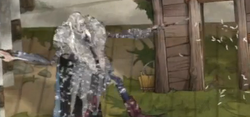
Raczidian's demise while trying to cast a Patronus
It is a general belief held by the wizarding world that only those who are pure of heart are able to cast Patronuses; this, however, is untrue, as several characters with negative personality traits are able to cast a fully-fledged Patronus.[4] Although generally dark witches and wizards will not try to produce a Patronus, not having any need for one, most dark wizards will be devoured by maggots coming from their wand and consuming the caster.[6]
For this reason, Lord Voldemort and his Death Eaters were not able to cast a Patronus Charm (not that it was necessary, as they already had the dark creatures under their control via their affinity to darkness, and would have no use for Patronuses).[17] Draco Malfoy numbered among those unable to cast the Patronus Charm. Severus Snape was the only Death Eater capable of casting the charm.[12]
Some witches and wizards of questionable morals, such as Dolores Umbridge, are able to produce corporeal Patronuses.[4][12] Merula Snyde could only conjure an incorporeal Patronus, though it should be noted that she was only a fourth year at the time and it is an advanced spell; the only other wizards known to produce a corporeal Patronus by that age are Harry Potter, Nymphadora Tonks, and Jacob's sibling.[18] Patricia Rakepick was a dark witch who sadistically tortured Merula Snyde with the Cruciatus Curse and murdered Rowan Khanna with the Killing Curse, and yet was able to cast a corporeal Patronus in the form of a Lioness.
The Patronus
A successfully conjured Patronus can take two forms: incorporeal and corporeal, and both types vary greatly in their appearances and strength.
Incorporeal
- "A thin wisp of silver escaped his wand and hovered like mist before him. "
- — Description of an incorporeal shield Patronus[src]
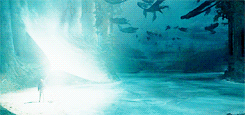
Harry Potter casting an incorporeal Patronus at the Black Lake
An incorporeal[19] Patronus is one which does not resemble any living creature and has few distinguishing features (if any). Incorporeal Patronuses resemble a burst of vapour or smoke without any clearly defined form shooting from the tip of the wand. While they may be partially effective at halting Dementors (but not repelling them) and shielding the caster from them, incorporeal Patronuses are not "fully-fledged" Patronuses, and are regarded as a simpler and weaker version of the Charm.
Corporeal
- Harry Potter: "What does a Patronus look like?"
- Remus Lupin: "Each one is unique to the wizard who conjures it."
- — Discussion of corporeal forms a Patronus can take[src]
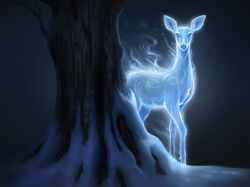
Severus Snape's doe Patronus is the same as Lily Potter's due to his lifelong love for her
A corporeal Patronus is one that is fully-formed, taking the shape of a bright-silver, translucent animal. It is the strongest form a Patronus can take, being able to fully drive Dementors away. The specific animal forms that a corporeal Patronus takes will vary from person to person and reflect each individual's innermost personality.
Patronus forms, however, are subject to change if the caster goes through an emotional upheaval of some sort, including falling in eternal, unchanging love.[20] For example, Nymphadora Tonks's Patronus changed from its previous form to that of a four-legged creature which others guessed was a wolf because then it would reflect her love for Remus Lupin, himself a werewolf.[11] Another example is Severus Snape, whose Patronus was that of a doe, the same as Lily Evans, though this may have been the case all along rather than a change from its original form, as Snape was in love with Lily for most of his life.
Based on the fact that Patronuses are conjured by recalling happy memories, it stands to reason that a Patronus might change its form after one falls in love and the memories used to conjure the Patronus largely revolve around the person the caster is in love with. In addition, it seems that some couples have "complementary" Patronuses (male and female forms of the same animal), such as Lily and James Potter. It is, however, unknown if this is a coincidence or not. If a wizard is an Animagus and can summon a corporeal Patronus, the two may take the same form, as was the case for Minerva McGonagall and James Potter.[12] Remus Lupin's Patronus takes the form of a wolf, rather than a werewolf; whether or not all werewolves would generate a similar Patronus is unknown. It stands to reason that it's likely due to Remus' best memories of his youth revolving around the acceptance he felt despite his condition, in which he felt more at home in his wolf form during those times, rather than cursed by it and also due to his nature as desiring a sense of belonging at his core, much like a true wolf.
Most Patronuses take the form of an ordinary animal. Magical creatures, such as Albus Dumbledore's phoenix Patronus, are uncommon. It is extremely rare for Patronuses to take the form of extinct animals. Hedley Fleetwood's Woolly Mammoth Patronus is a notable exception.[6] Andros the Invincible was the only wizard capable of casting a Patronus the size of a Giant,[21] although whether it was a giant or not is unknown.
The corporeal Patronus is also better at repelling Dementors than the non-corporeal form.
Uses
There are two known uses for the Patronus Charm. The first and main use of the Patronus is to drive off certain Dark creatures, such as Dementors and Lethifolds and is the only known charm that will work against them. As Dementors feed on happy memories causing humans to drown in their own sorrow and sadness, the Patronus acts as a shield of sorts, of which the Dementor would try to feed off instead — the Patronus is comprised exclusively of positive feelings and cannot comprehend negative emotion, so the Dementor's influence cannot affect it.

Harry casting a Patronus during the hunt for Horcruxes
The other use was devised by Albus Dumbledore, who invented a way of using the Patronus (corporeal and non) as a means of communication. They can deliver messages, speaking with the voice of the caster. This source of communication is believed to be exclusive to the members of the Order of the Phoenix. Using the Patronus for communication offers great advantages in security, as Patronuses identify the caster and are Dark Arts-proof.[11] A good example of this was when Minerva McGonagall used her feline Patronus to call for help to the other heads of houses in 1998, when she found out that Harry Potter had returned to Hogwarts in search of Rowena Ravenclaw's Diadem.[12]
Multiple Patronuses can be cast for communication, as McGonagall was able to create three. Another is when Severus Snape used his Patronus to lead Harry Potter to a pool in the Forest of Dean in 1997, where he had laid Godric Gryffindor's Sword for Harry to retrieve. It is unknown if Snape had conjured the Patronus with instructions or if he was hiding and controlling it for this task. Harry's Patronus was able to follow both oral and physical commands. They also only remain active whilst the caster is focusing on them. If they are not protecting anyone, Patronuses seem to take on the traits of the creature they resemble and generally follow their caster around. This makes it unsure whether or not they are sentient.
Patronuses and practitioners
| Witch/wizard | Patronal form | Notes |
|---|---|---|
| Andros the Invincible | Something allegedly the size of a Giant[21] | Stated on his Chocolate Frog Card as the only wizard to make a Patronus that size.[21] |
| Illyius | Mouse[6] | Initially, Illyius's fellow villagers mocked him as they had never seen such a small and weak-looking Patronus, which corresponded to Illyius's timidity and for being tongue-tied. However, when the Dark Wizard Raczidian invaded and terrorised the village with his army of Dementors, Illyius's mouse Patronus proved to be stronger than the others, making him a hero.[6] |
| Flavius Belby | Something with horns[22] | In Fantastic Beasts and Where to Find Them, it is recorded that he cast off a Lethifold by performing the Patronus Charm. It says the Lethifold was thrown into the air on the horns of his Patronus.[22] |
| Cho Chang | Swan | Seen in the last Dumbledore's Army meeting in 1996. |
| Aberforth Dumbledore | Goat | Summoned outside the Hog's Head in an attempt to convince the Death Eaters who had seen Harry's Patronus that they really saw a goat. |
| Albus Dumbledore | Phoenix | The bird whose loyalty he earned, Fawkes, was a phoenix. He used it in 1995 as a message to Hagrid when Krum was stunned. It was described as "a ghostly bird that flew off in the direction of Hagrid's house". A rare form.
 |
| Seamus Finnigan | Fox | He could not produce a fully formed corporeal Patronus in Dumbledore's Army, though, in the Battle of Hogwarts in 1998, he managed to conjure a Patronus in the shape of a fox. |
| Hedley Fleetwood | Woolly mammoth | An unusual form due to the extreme rarity of Patronuses based on extinct animals. |
| Hermione Granger | Otter | Seen in the last Dumbledore's Army meeting in 1996. It is apparently the only spell Hermione had trouble with, as said in 1997 while escaping from the Ministry of Magic. |
| Harry Potter | Stag | Harry's Patronus was in the shape of his father's Animagus form and Patronus. He learned how to conjure a Patronus at an exceptionally young age.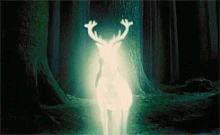 |
| James Potter | James' Animagus form was also that of a stag. | |
| Luna Lovegood | Hare | Seen in the last Dumbledore's Army meeting in 1996 and in the Battle of Hogwarts in 1998. |
| Ernie Macmillan | Boar | Seen in the Battle of Hogwarts in 1998.[12] |
| Minerva McGonagall | Cat | Just before the Battle of Hogwarts, she sent her Patronus out to alert the other Heads of House that Hogwarts Castle would soon be under attack by Lord Voldemort and his followers.[12] |
| Dolores Umbridge | While interrogating Muggle-borns at a trial, she had cast a Patronus to ward the Dementors from the prosecutors. Her favourite animal, as shown by the many plates with cats on them in her office. She was able to cast the Patronus due to her affinity with the locket Horcrux's evil influence.[12] | |
| Lily Potter | Doe | Mentioned in conjunction with Snape's Patronus. It was also the female form of her husband's Patronus. |
| Severus Snape | Acted as Harry's guide through the woods to where Godric Gryffindor's Sword was hidden. Snape's Patronus mirrored Lily's due to his unspoken love for her that began when they were small children.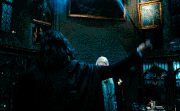 | |
| Cast by Severus Snape to aid Scorpius Malfoy and himself in the alternate reality created by Albus Potter and Scorpius in 2020. | ||
| Symposia Rawle | Ladybird[6] | An unusual form that was very powerful despite its tiny size.[6] |
| Kingsley Shacklebolt | Lynx | Seen in 1997 when he warned the Order during Bill and Fleur's wedding of the downfall of the Ministry of Magic and Rufus Scrimgeour's death.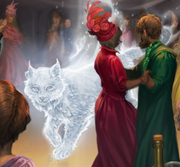 |
| Nymphadora Tonks | Jack rabbit[4] | Tonks learned the Patronus Charm at some point by or during her fourth year.[18] Her Patronus originally took the form of a jackrabbit. |
| Wolf | The form of Tonks' Patronus changed in 1996. It became a wolf due to her love for Remus Lupin. Changes of Patronus are rare and usually caused by devastating life traumas. Occasionally when a witch and a wizard are married, their Patronuses will match each other (most likely because the witch/wizard's happy thought will be that of their spouse). | |
| Remus Lupin | Remus often deliberately disguised the form of his Patronus because he felt that it would give away too much about his condition, being a werewolf.[4][24] | |
| Arthur Weasley | Weasel | First seen when he sent a message about Rufus Scrimgeour's arrival on Harry's seventeenth birthday. Later seen when Arthur sent a Patronus to 12 Grimmauld Place to inform Harry, Ron and Hermione that the Weasley family was safe. |
| Ginny Weasley | Horse | Seen in the last Dumbledore's Army meeting in 1996.[15] |
| Ron Weasley | Jack Russell terrier | Seen in the last Dumbledore's Army meeting in 1996 and in the Battle of Hogwarts in 1998. |
| Jacob's sibling | Either a White Stallion, Unicorn, Abraxan,
Tiger, Cheetah, Leopard, Spotted Hare, Mountain Hare or Lop-Eared Rabbit[18] |
In their fourth year, they learnt the charm under Tonks' tutelage.[18] |
| Patricia Rakepick | Lioness[26] | An unusual forrm, as lions were not native to Great Britain.[4] Used it to banish several Dementors in the Forbidden Forest in 1990.[26] |
| Constance Pickering | Unicorn[27] | A rare form, given how a unicorn is a magical creature.[4] |
Patronus forms
Etymology
Patronus is the nominative singular case meaning "protector", "guardian", or simply "patron" in Latin, specifically reflecting the entire role that the Patronus Charm plays. In archaic Latin, it meant "father", which is very interesting, considering that Harry Potter's Patronus is the same as his father's Patronus and Animagus form, a stag. The Latin word exspecto is the first person singular form of exspectare meaning "to await", thus the charm's incantation translates into "I await a patron" (since patronum is the singular accusative form of patronus, meaning it is the case which a noun or an adjective describing the noun takes when it is the direct object of a sentence, which in the spell's translation, it is).
Behind the scenes
- " [...] the Patronus often mutates to take the image of the love of one's life (because they so often become the 'happy thought' that generates a Patronus). "
- — J. K. Rowling[src]

The spell's symbol in Harry Potter and the Prisoner of Azkaban (video game)
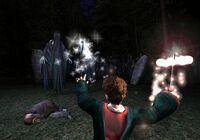
The Patronus Charm as seen in Harry Potter and the Prisoner of Azkaban (video game)
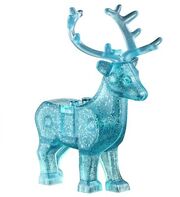
The Patronus Charm in LEGO form

Harry Potter's stag Patronus in POP! Vinyl form
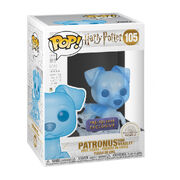
Ron Weasley's dog Patronus in POP! Vinyl form

Hermione Granger's otter Patronus in POP! Vinyl form
- SPSexpecto from SpellShapes.utx from the texture files of the third video game PC version.
- Two Patronuses planned for the films but ultimately cut include a Thestral and a chimpanzee.[28]
- The Patronuses of James Potter and Minerva McGonagall match their respective Animagi form. These are the only characters whose Patronus and Animagus forms are known. However, not all Animagi have the same animal as their Patronus and Animagus.[29]
- Similarly Remus Lupin's Patronus is a wolf, but whether this is universal among werewolves or not is unknown.
- In the first chapter of Harry Potter and the Deathly Hallows, a white peacock appears in the gardens of Malfoy Manor. Some fans believed this bird to be Lucius Malfoy's Patronus. However, J. K. Rowling stated that no Death Eater except Severus Snape could (or had a need to) conjure a Patronus, because Death Eaters fight alongside that which Patronuses fight against.[30] This means that the peacock was in fact a living creature. It is stated in Harry Potter and the Deathly Hallows that the creature was in fact an albino peacock.
- In the video game adaptation of Harry Potter and the Prisoner of Azkaban, the more moderate Expecto Patronum is a ball of light. In the console versions, it works as a guided-missile that can only be steered left or right, and accelerate. In the PC version, before being cast, a white ring goes up Harry's arm and if it reaches the top of the wand, Harry has to try the spell again, and it is used only to attack Dementors (it also produces lightning effects). At the climax of the game, a stag (Harry's Patronus) jumps out of the wand to drive away all the Dementors nearby attacking Harry and Sirius, and its during that battle in the console versions, Harry's Patronus changes into a stag with altered controls.
- In the said video game, the first video game adaption of Harry Potter and the Deathly Hallows, and LEGO Harry Potter: Years 1-4/5-7 the Patronus Charm appears to push the Dementors away with the first shot, and a second shot kills them.
- The lecture that Harry gives on Patronuses to Dumbledore's Army in the film adaptation of Harry Potter and the Order of the Phoenix is extremely similar to the lecture Remus Lupin gave him in the film adaptation of Harry Potter and the Prisoner of Azkaban.
- In the third book when Dementors attack Harry, Hermione and Sirius, Harry's Patronus is very weak and thin (based on how there were tons of Dementors) yet the Dementors were still unable to pass through it. One Dementor was able to make it vanish by gesturing at it though.
- In Harry Potter and the Deathly Hallows: Part 1, Dolores Umbridge's Patronus seems to emanate a shield that keeps the Dementors separated from everyone in the courtroom. In addition, Kingsley Shacklebolt's Patronus is described in the novel as taking the form of a lynx; however, in the film it is depicted as a shimmering comet of light from which springs silvery images of witches and wizards screaming in terror as Kingsley's voice details the death of Scrimgeour and the fall of the Ministry.
- In LEGO Harry Potter: Years 1-4, Voldemort, Lucius Malfoy, Walden Macnair, Barty Crouch Jnr, and an unnamed Death Eater can all cast the spell, despite the fact that Rowling stated that no Death Eater besides Severus Snape could produce a Patronus. It is most likely that this was simply incorporated for gameplay purposes.[31]
- According to W.O.M.B.A.T., it is possible that Patronuses vary in strength according to which animal's form they take. Later canon from Wonderbook: Book of Spells, however, stresses that this is not the case and that the form of the animal has no correlation to the strength of the Patronus (see, for instance, Illyius and Symposia Rawle).
- In an interview, J. K. Rowling stated that the happy memory that would produce the strongest Patronus for her would be the births of any of her three children, though a close fourth would be when she learned that Harry Potter and the Philosopher's Stone was going to be published.[32] She has also stated that she'd like for her Patronus to be an otter, like Hermione's, but she has a feeling it might actually be a large dog.[30] However, in a message on Twitter in 2014, she claimed it would be a pine marten.[33] Additionally, in a 2000 interview, she stated that the Patronus Charm was her favourite spell in the series so far.[34] Rowling later revealed that a pine marten was what she had tested as in the initial form of the Patronus test that was later posted on Pottermore. She took the test again in its final form and tested as a heron.[35]
- Luna Lovegood's hare Patronus is possibly a reference to the moon rabbit, a figure in East Asian mythology.
- Learning to cast a Patronus is one of the tasks given to the player in the final Chapter of the game Wonderbook: Book of Spells. For learning the incantation and gesture, the player is given the Trophy "Expecto Patronum!" On the next page, the player is given the chance to cast a true Patronus, the form of which is apparently chosen randomly. Amongst the possible Patronuses are a bat, a bull, a cat, a goat, a horse, a rabbit, a scorpion and a snake.[36] For discovering their Patronus, the player is awarded the Trophy "True Patronus.""
- J.K Rowling has stated the only way that a Patronus is able to change its current form is through eternal unchangable love.
- Although J. K. Rowling has stated that the plural form is Patronuses and not Patroni, the German translation always translates it as Patroni.
- J. K. Rowling confirmed on 21 August 2015 on Twitter that Rubeus Hagrid was not able to conjure a Patronus, though he was a member of the Order of the Phoenix.[14]
- On 22 September, 2016, Pottermore unveiled the long-awaited and discussed option for members of the site to determine their patronus. This takes the form of a quiz of several questions that can only be taken once, at which point the member's Patronus is revealed and added to their member profile.[37]
- When Joanne K. Rowling was asked about the form of Newton Scamander's Patronus, she said that it would be a spoiler to future films of the Fantastic Beasts series.[38]
- On Pottermore, a horse Patronus can be of several different colours, though all Patronuses are silver. It's unknown how hard the difference is to tell in-universe since all horse Patronuses look the same, or at least very similar, on Pottermore.
Patronuses in the films
- In the film adaptation of Harry Potter and the Order of the Phoenix, Harry's Patronus physically attacks the Dementors by charging at them, as depicted in the books, with the first successful patronus shield he conjured being used to force a Boggart in the form of a Dementor back into its trunk. Also, Patronuses produced by the members of Dumbledore's Army make noises and are capable of interacting with physical objects, such as Ron's dog Patronus knocking over Neville Longbottom. Also, in Harry Potter and the Deathly Hallows: Part 1, Umbridge's Patronus was heard hissing.
- There was a noted change in appearance of Patronuses in general in the Order of the Phoenix movie. In movies 5-8, Patronuses appear to be very wispy and airy, while in the third film they look more substantial, solid and brighter.
- In Harry Potter and the Deathly Hallows: Part 1, during the infiltration of the Ministry of Magic, Umbridge's Patronus was very clearly seen several times in the same scene and often looked less like a cat and more like a reanimated, feline corpse, with the skeletal features visible. This is odd for a Patronus (they usually look quite 'alive' and well) and its twisted form may be a nod to both Umbridge's nature and the circumstances under which it was cast.
- In the film adaptation of Harry Potter and the Prisoner of Azkaban, the Patronus in its powerful wave-like form emits a deep reverberating sound. In Harry Potter and the Deathly Hallows: Part 2, this effect was also used when Aberforth Dumbledore protected Hogwarts from Dementors.
Appearances

Patronus charm as appears in Harry Potter: Wizards Unite
- Harry Potter and the Philosopher's Stone (video game) (Appears on a Famous Wizard Card)
- Harry Potter and the Chamber of Secrets (video game) (Appears on a Famous Wizard Card)
- Harry Potter and the Prisoner of Azkaban (First appearance)
- Harry Potter and the Prisoner of Azkaban (film)
- Harry Potter and the Prisoner of Azkaban (video game)
- Harry Potter and the Goblet of Fire
- Harry Potter and the Goblet of Fire (film) (Disc 2)
- Harry Potter and the Order of the Phoenix
- Harry Potter and the Order of the Phoenix (film)
- Harry Potter and the Order of the Phoenix (video game)
- Harry Potter and the Half-Blood Prince
- Harry Potter and the Half-Blood Prince (video game) (iPhone version only)
- Harry Potter and the Deathly Hallows
- Harry Potter and the Deathly Hallows: Part 1
- Harry Potter and the Deathly Hallows: Part 1 (video game)
- Harry Potter and the Deathly Hallows: Part 2
- Harry Potter and the Deathly Hallows: Part 2 (video game)
- Harry Potter and the Cursed Child (Appears in alternate realities)
- Harry Potter and the Cursed Child (play) (Appears in alternate realities)
- Fantastic Beasts and Where to Find Them
- LEGO Harry Potter: Years 1-4
- LEGO Harry Potter: Years 5-7
- LEGO Dimensions
- LEGO Harry Potter
- Harry Potter for Kinect
- Harry Potter: Spells
- Wonderbook: Book of Spells
- Pottermore
- Wizarding World
- Harry Potter: The Character Vault (Mentioned only)
- Harry Potter: The Creature Vault (Mentioned only)
- Harry Potter: Hogwarts Mystery
- Harry Potter: Wizards Unite
Notes and references
- ↑ 1.0 1.1 1.2 1.3 1.4 1.5 1.6 1.7 Harry Potter and the Prisoner of Azkaban, Chapter 12 (The Patronus)
- ↑ Harry Potter and the Prisoner of Azkaban (film)
- ↑ 3.0 3.1 JKR Official Site (Text only, accessed 8 February, 2012 via the Wayback Web Archive)
- ↑ 4.00 4.01 4.02 4.03 4.04 4.05 4.06 4.07 4.08 4.09 4.10 4.11 4.12 4.13 4.14 Writing by J. K. Rowling: "Patronus Charm" at Wizarding World
- ↑ "The Rules" at AccioQuote!
- ↑ 6.00 6.01 6.02 6.03 6.04 6.05 6.06 6.07 6.08 6.09 6.10 Wonderbook: Book of Spells
- ↑ Harry Potter and the Prisoner of Azkaban, Chapter 13 (Gryffindor versus Ravenclaw)
- ↑ Harry Potter and the Prisoner of Azkaban, Chapter 20 (The Dementor's Kiss)
- ↑ Harry Potter and the Prisoner of Azkaban, Chapter 21 (Hermione's Secret)
- ↑ Harry Potter and the Goblet of Fire, Chapter 31 (The Third Task)
- ↑ 11.0 11.1 11.2 11.3 11.4 11.5 Harry Potter and the Order of the Phoenix
- ↑ 12.00 12.01 12.02 12.03 12.04 12.05 12.06 12.07 12.08 12.09 12.10 12.11 Harry Potter and the Deathly Hallows
- ↑ Harry Potter and the Prisoner of Azkaban (video game)
- ↑ 14.0 14.1 Hagrid couldn't produce a Patronus. It's a very difficult spell. by J.K. Rowling on Twitter
- ↑ 15.0 15.1 15.2 Harry Potter and the Order of the Phoenix (film)
- ↑ Harry Potter and the Cursed Child
- ↑ J.K. Rowling and the Live Chat, Bloomsbury.com, July 30, 2007 (2.00-3.00pm BST) at Accio Quote!
- ↑ 18.0 18.1 18.2 18.3 Harry Potter: Hogwarts Mystery, Year 4, Side Quest "Unleash Your Patronus"
- ↑ Pottermore describes "non-corporeal" Patronuses as "incorporeal"
- ↑ .@tigs25 Your Patronus only changes if it's eternal love, unchanging - part of you forever. by J.K. Rowling on Twitter
- ↑ 21.0 21.1 21.2 Harry Potter and the Chamber of Secrets (video game)
- ↑ 22.0 22.1 Fantastic Beasts and Where to Find Them
- ↑ "Harry Latino Interview" retrieved from Snitch Seeker
- ↑ 24.0 24.1 Writing by J. K. Rowling: "Remus Lupin" at Wizarding World
- ↑ "Leaky Cauldron and MuggleNet Interview with J. K. Rowling" retrieved from Accio Quote!
- ↑ 26.0 26.1 Harry Potter: Hogwarts Mystery, Year 6, Chapter 18 (Into the Forest)
- ↑ Harry Potter: Wizards Unite - Baby Beasts
- ↑ Harry Potter Limited Edition
- ↑ In Harry Potter: Hogwarts Mystery, the options for the Patronus and Animagus form of Jacob's sibling are different.
- ↑ 30.0 30.1 The Leaky Cauldron - J.K. Rowling July 30, 2007 Bloomsbury.com chat
- ↑ J.K. Rowling and the Live Chat, Bloomsbury.com, July 30, 2007
- ↑ Harry Potter: A Blue Peter Special interview, transcript available here
- ↑ Twitter account of J.K. Rowling
- ↑ AOL Live Interview - October 19, 2000
- ↑ Discover your Patronus on Pottermore
- ↑ See this YouTube video's comments
- ↑ My Pottermore - Patronus
- ↑ https://twitter.com/jk_rowling/status/857287597579788288


